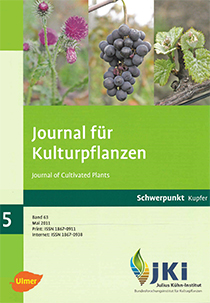Monitoring of total copper contents in organically and conventionally managed soils. Part 2: Total contents in German hop soils
DOI:
https://doi.org/10.5073/JfK.2011.05.02Keywords:
Total content of copper, control of fungi, hop downy mildew, Pseudoperonospora humuli, organically and conventionally managed hop soils, load situation in hop culture, risk potential, exposure assessment, pre-selection of adequate monitoring areasAbstract
Soil samples were taken from 9 conventionally and 4 organically managed hop growing sites, considering all aspects that are relevant for a representative assessment of copper loads. The result of this survey is intended to enable the selection of characteristical cultivation types for each site, which, in combination with a refined exposure analysis, are a prerequisite for the assessment of the effects of copper on earthworm coenoses.
Based on total contents, the copper load and its distribution on test and reference fields of German hop cultivation sites is presented. Additionally, the heavy metal content was determined in general, and differences in copper contents between and within hop rows were identified.
The management history of the hop sites led to additional heavy metal soil contamination (As, Cr, Pb, Zn, V). Due to different cultural measures exercised in the past, the analyzed total heavy metal contents differ between growing regions.
Comparing literature with managing history and current management, it is obvious that peaks of contamination result from applications between 1924 and 1965, when for the control of plant diseases up to 60 kg copper per ha and year were used.
The collected data concerning load situation, site description and duration of management suggest that three hop sites are appropriate for a biological assessment of soil quality and its recent impact on earthworm coenoses.
Downloads
Published
Issue
Section
License
The content of the journal is licensed under the Creative Commons Attribution 4.0 License. Any user is free to share and adapt (remix, transform, build upon) the content as long as the original publication is attributed (authors, title, year, journal, issue, pages).
The copyright of the published work remains with the authors. The authors grant the Journal of Cultivated Plants, the Julius Kühn-Institut and the OpenAgrar repository the non-exclusive right to distribute and exploit the work.







